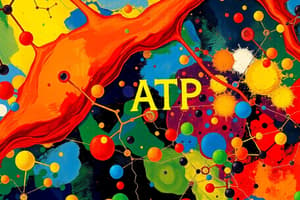Podcast
Questions and Answers
What is the primary function of ATP in cellular metabolism?
What is the primary function of ATP in cellular metabolism?
- To oxidize fatty acids to Acetyl CoA
- To serve as the energy currency of the cell (correct)
- To store energy for long-term use
- To participate in the synthesis of glucose
During anaerobic conditions, what is the end product of glycolysis?
During anaerobic conditions, what is the end product of glycolysis?
- Lactate (correct)
- Acetyl CoA
- Pyruvate
- NADH
What is the primary fate of glucogenic amino acids?
What is the primary fate of glucogenic amino acids?
- Being converted directly to ATP
- Forming the precursor for the synthesis of fatty acids
- Being stored in adipose tissue
- Serving as the precursor for the synthesis of glucose (correct)
What is the primary energy source utilized by the body during fasting conditions?
What is the primary energy source utilized by the body during fasting conditions?
What is the role of the liver in the integration of metabolism?
What is the role of the liver in the integration of metabolism?
What is the primary function of fatty acid oxidation?
What is the primary function of fatty acid oxidation?
What is the end product of the citric acid cycle?
What is the end product of the citric acid cycle?
Which hormone is responsible for controlling metabolism in various organs of the human body during the fed state?
Which hormone is responsible for controlling metabolism in various organs of the human body during the fed state?
What is the primary function of the hexose monophosphate shunt?
What is the primary function of the hexose monophosphate shunt?
What is the storage form of glucose in the liver and muscle?
What is the storage form of glucose in the liver and muscle?
What is the common metabolite produced from different fuel sources that enters the citric acid cycle?
What is the common metabolite produced from different fuel sources that enters the citric acid cycle?
What is the mechanism of regulation of enzyme synthesis in metabolic pathways?
What is the mechanism of regulation of enzyme synthesis in metabolic pathways?
What is the primary function of the liver in the absorptive state?
What is the primary function of the liver in the absorptive state?
In the absorptive state, what is the primary source of fuel for the brain?
In the absorptive state, what is the primary source of fuel for the brain?
Which tissue has increased fatty acid and triacylglycerol synthesis in the absorptive state?
Which tissue has increased fatty acid and triacylglycerol synthesis in the absorptive state?
What happens to glycogen in the liver during the absorptive state?
What happens to glycogen in the liver during the absorptive state?
What is the fate of amino acids in skeletal muscle during the absorptive state?
What is the fate of amino acids in skeletal muscle during the absorptive state?
What happens to triacylglycerol in adipose tissue during the absorptive state?
What happens to triacylglycerol in adipose tissue during the absorptive state?
What is the primary source of energy for the brain and muscle during normal conditions?
What is the primary source of energy for the brain and muscle during normal conditions?
During fasting, which of the following is the primary energy source for the body?
During fasting, which of the following is the primary energy source for the body?
What is the fate of excess acetyl CoA during fasting?
What is the fate of excess acetyl CoA during fasting?
Which of the following hormones is decreased during fasting?
Which of the following hormones is decreased during fasting?
What is the primary function of hepatic gluconeogenesis during fasting?
What is the primary function of hepatic gluconeogenesis during fasting?
During fasting, which of the following is not a primary source of energy for the brain?
During fasting, which of the following is not a primary source of energy for the brain?
In the fasting state, what is the primary source of glucose for the brain?
In the fasting state, what is the primary source of glucose for the brain?
What is the fate of glycerol liberated during lipolysis in adipose tissue during starvation?
What is the fate of glycerol liberated during lipolysis in adipose tissue during starvation?
What is the primary fuel used by the skeletal muscle during prolonged fasting?
What is the primary fuel used by the skeletal muscle during prolonged fasting?
What is the role of muscle protein breakdown during starvation?
What is the role of muscle protein breakdown during starvation?
What signals a reduction in protein catabolism during prolonged starvation?
What signals a reduction in protein catabolism during prolonged starvation?
What is the primary fate of fatty acids released from adipose tissue during starvation?
What is the primary fate of fatty acids released from adipose tissue during starvation?
Flashcards
Acetyl CoA
Acetyl CoA
A common metabolic intermediate produced from various fuel sources that enters the citric acid cycle.
Citric Acid Cycle
Citric Acid Cycle
A metabolic pathway that oxidizes Acetyl CoA, producing energy in the form of NADH and FADH2.
Oxidative Phosphorylation
Oxidative Phosphorylation
The process of generating ATP from NADH and FADH2 using the electron transport chain.
Hexose Monophosphate Shunt
Hexose Monophosphate Shunt
Signup and view all the flashcards
NADPH
NADPH
Signup and view all the flashcards
Ribose Sugar
Ribose Sugar
Signup and view all the flashcards
Gluconeogenesis
Gluconeogenesis
Signup and view all the flashcards
Glycogen
Glycogen
Signup and view all the flashcards
Substrate Availability
Substrate Availability
Signup and view all the flashcards
Covalent Modification of Enzymes
Covalent Modification of Enzymes
Signup and view all the flashcards
Allosteric Regulation
Allosteric Regulation
Signup and view all the flashcards
Regulation of Enzyme Synthesis
Regulation of Enzyme Synthesis
Signup and view all the flashcards
Insulin
Insulin
Signup and view all the flashcards
Liver
Liver
Signup and view all the flashcards
Muscle
Muscle
Signup and view all the flashcards
Adipose Tissue
Adipose Tissue
Signup and view all the flashcards
Gluconeogenesis (During Fasting)
Gluconeogenesis (During Fasting)
Signup and view all the flashcards
Lipolysis
Lipolysis
Signup and view all the flashcards
Ketone Bodies
Ketone Bodies
Signup and view all the flashcards
Protein Catabolism
Protein Catabolism
Signup and view all the flashcards
Early Phase of Starvation
Early Phase of Starvation
Signup and view all the flashcards
Prolonged Starvation
Prolonged Starvation
Signup and view all the flashcards
Liver (During Fasting)
Liver (During Fasting)
Signup and view all the flashcards
Triacylglycerol (TG)
Triacylglycerol (TG)
Signup and view all the flashcards
Brain Metabolism
Brain Metabolism
Signup and view all the flashcards
Integration of Metabolism
Integration of Metabolism
Signup and view all the flashcards
Muscle (During Fasting)
Muscle (During Fasting)
Signup and view all the flashcards
Study Notes
Citric Acid Cycle and Oxidative Phosphorylation
- Acetyl CoA is the common metabolite produced from different fuel sources.
- It enters the citric acid cycle and gets oxidized to CO2.
- Most of the energy is trapped in the form of NADH and FADH2.
- Oxidative phosphorylation: NADH and FADH2 are oxidized in the electron transport chain, generating ATP.
Hexose Monophosphate Shunt
- Concerned with the liberation of NADPH.
- NADPH is utilized for biosynthesis of several compounds, including fatty acids and ribose sugar.
- Ribose sugar is an essential component of nucleotides.
Gluconeogenesis
- Many non-carbohydrate compounds serve as precursors for gluconeogenesis.
- Glucose is synthesized from these precursors.
Glycogen Metabolism
- Glycogen is the storage form of glucose in liver and muscle.
- Glycogen serves as a fuel reserve to meet body needs for a brief period.
Regulation of Metabolic Pathways
- Metabolic pathways are controlled by four mechanisms:
- Availability of substrates
- Covalent modification of enzymes
- Allosteric regulation
- Regulation of enzyme synthesis
Integration of Metabolism during Fed State
- Insulin is the hormone responsible for controlling metabolism in various organs of the body.
- The liver, muscle, and adipose tissue work together to meet the body's metabolic demands.
Carbohydrate, Lipid, and Protein Metabolism during Fasting
- Glucose production and utilization:
- Liver: Glucose production increases through gluconeogenesis.
- Adipose tissue: Glucose uptake and metabolism decrease.
- Skeletal muscle: Glucose uptake and metabolism decrease.
- Brain: Glucose is the primary fuel source.
- Lipid metabolism:
- Adipose tissue: Lipolysis increases, releasing fatty acids (FA) and glycerol.
- Skeletal muscle: FA and ketone bodies are utilized as fuel.
- Liver: FA oxidation increases, and ketone bodies are produced.
- Protein metabolism:
- Skeletal muscle: Muscle proteins are degraded, and amino acids are utilized for glucose synthesis in the liver.
- Liver: Amino acids are utilized for glucose synthesis.
Brain Metabolism during Fasting
- In the early phase of starvation, the brain depends on glucose supplied by liver gluconeogenesis.
- In prolonged starvation, ketone bodies replace glucose as the primary fuel for the brain.
- This reduces protein catabolism.
Integration of Metabolism during Fasting
- The liver, muscle, and adipose tissue work together to meet the body's metabolic demands during fasting.
- The metabolism is reorganized to meet the new demands of fasting.
- Glucose is the fuel of choice for brain and muscle.
- Protein meets the fuel demands of the body.
- Triacylglycerol (TG) of adipose tissue is the predominant energy reserve of the body.
Liver during Fasting
- Carbohydrate metabolism:
- Increased glycogen degradation and gluconeogenesis.
- Complete dependence on hepatic gluconeogenesis from lactate and alanine.
- Lipid metabolism:
- Increased FA oxidation and ketone body formation.
- Ketone bodies meet the fuel demands of the brain.
Studying That Suits You
Use AI to generate personalized quizzes and flashcards to suit your learning preferences.



